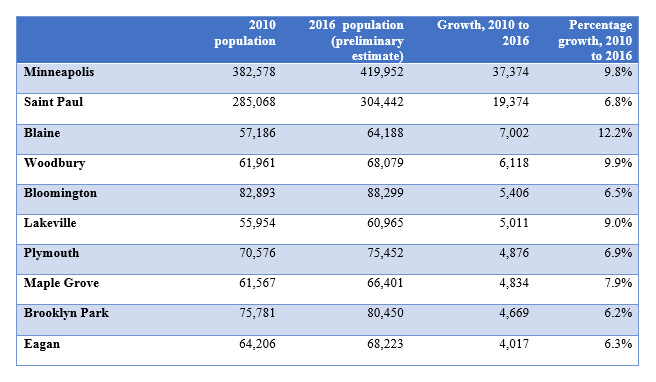Carver County has surpassed a population of 100,000 for the first time, and the central cities continue to lead population growth in the region. Those are among the findings from the Metropolitan Council’s community-level preliminary population estimates for 2016.
The Council, per statute, annually prepares population and household estimates for all metro-area communities. Local government officials can review and comment on the preliminary estimates through June 24. In some cases, the Council may make adjustments based on community feedback.
The Council will certify the estimates July 15. The estimates are the official population and household estimates for state government purposes, including how local government aid (LGA) and local street aid allocations are determined.
See a spreadsheet with the 2016 population estimates (Excel).
Household growth outpaces housing construction, tightening vacancy rates and raising prices
Among the findings from the preliminary estimates:
-
Growth continues to occur across the region with the strongest growth occurring in urban and suburban areas. The communities that have added the most people since 2010 are Minneapolis, Saint Paul, Blaine, Woodbury, Bloomington, Lakeville, Plymouth, Maple Grove, Brooklyn Park, and Eagan.
-
The seven-county region added 74,615 households between 2010 and 2016, but just 56,205 housing units. The remaining 18,410 households occupied existing housing, drawing down vacancy rates.
-
Vacancy rates dropped as the economy improved after 2010 and reached an estimated 4.1% in 2016, down from 5.8% in the 2010 Census. According to annual data from the U.S. Census Bureau’s Current Population Survey, vacancy rates in our region are at their lowest since the early 2000s, and they are some of the lowest in the country.

Council officials say growth reflects a diversified, competitive economy, but the challenge remains to invest in key areas:
-
Transit to ensure mobility and connect people to jobs
-
Development that is transit-friendly and promotes efficient land use
-
Housing that’s affordable and safe
-
Water that’s clean and abundant
Most growth occurred in region’s center
The preliminary estimates show that growth is occurring throughout the Twin Cities. The communities that have added the most people since 2010 are:

About the estimates
The Council’s estimates differ from those developed by the U.S. Census Bureau, scheduled for release on May 25. The Census Bureau uses an estimation method that relies on birth rates, death rates, and migration rates to arrive at county populations, then apportions those county populations to the various communities.
The Council’s method uses American Community Survey data and takes advantage of the latest available local information on each community’s housing stock, vacancy rate, and group quarters population.
Table 1: Population of 7-county metro area from 2010 to 2016
-
Population of seven-county metro area, April 1, 2010: 2,849,567; preliminary estimate for April 1, 2016: 3,041,195; change from 2010 to 2016: 191,628; percent change in same period: 6.7%.
-
Households in seven-county metro area, April 1, 2010: 1,117,749; preliminary estimate for April 1, 2016: 1,192,364; change from 2010 to 2016: 74,615; percent change in same period: 6.7%.
-
Total housing units in seven-county metro area, April 1, 2010: 1,186,986; preliminary estimate for April 1, 2016: 1,243,191; change from 2010 to 2016: 56,205; percent change in same period: 4.7%.
Table 2: Ten Twin Cities communities that have added the most people since 2010
Ten communities that have added the most people since 2010. Note: All numbers for 2016 are preliminary estimates.
-
Minneapolis grew from 382,578 in 2010 to 419,952 in 2016, adding 37,374 people and growing 9.8%.
-
Saint Paul grew from 285,068 in 2010 to 304,442 in 2016, adding 19,374 people and growing 6.8%.
-
Blaine grew from 57,186 in 2010 to 64,188 in 2016, adding 7,002 people and growing 12.2%.
-
Woodbury grew from 61,961 in 2010 to in 2016, adding 6,118 people and growing 9.9%.
-
Bloomington grew from 82,893 in 2010 to 88,299 in 2016, adding 5,406 people and growing 6.5%.
-
Lakeville grew from 55,954 in 2010 to 60,965 in 2016, adding 5,011 people and growing 9.0%.
-
Plymouth grew from 70,576 in 2010 to 75,452 in 2016, adding 4,876 people and growing 6.9%.
-
Maple Grove grew from 61,567 in 2010 to 66,401 in 2016, adding 4,834 people and growing 7.9%.
-
Brooklyn Park grew from 75,781 in 2010 to 80,450 in 2016, adding 4,669 people and growing 6.2%.
-
Eagan grew from 64,206 in 2010 to 68,223 in 2016, adding 4,017 people and growing 6.3%.